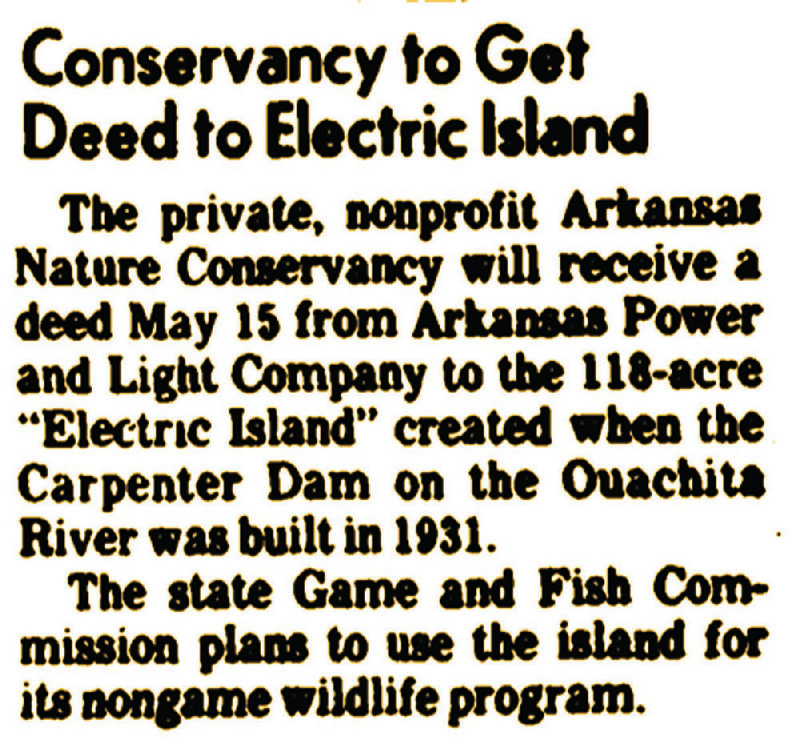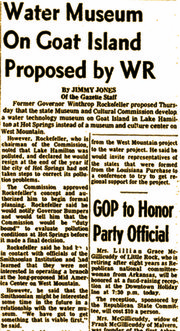As Chris Colclasure said during the Sept. 21 opening for the Electric Island Nature Trail at Lake Hamilton, the island has a cool name.
"Neat name, neat place," the deputy director of the Arkansas Game and Fish Commission said.
Not that it looks especially electric. It looks the opposite.
But it recalls its former owner, Arkansas Power & Light Co. (today known as Entergy).
I won't annoy you by trying to rehash the history of electricity in Arkansas. If you don't already know it better than I do, you could look it up. Start with Harvey Couch Sr. (1877-1941). He was the Arkansas-born entrepreneur who in 1914 figured out how to bring electric lights to Malvern and Arkadelphia 24 hours a day by burning dust from a sawmill.
Burn the sawdust to boil water, creating steam to power two turbines that generate electricity. Done.
He expanded that operation into AP&L, which conducted amazing engineering feats: dams on the Ouachita River, hydroelectric plants, manmade lakes! And so we have Remmel Dam, Carpenter Dam and (thanks to the U.S. Army Corps of Engineers) Blakely Mountain Dam, and Lake Catherine -- named for Couch's daughter -- and Lake Hamilton, named after AP&L's lawyer Hamilton Moses.
View I | View II | OLD NEWS: Plans floated, then forgotten | Electric Island opens a peaceful path in buzzy Lake Hamilton | Island open to the public
Blakely was built after Couch died, and so he had no hand in the naming of its mighty pond, the more impersonal Lake Ouachita.
Couch also did not name Electric Island. During his lifetime, the 118-acre blob in Lake Hamilton was known as Goat Island, or Big Goat Island.
Who knows why? Some say it looks like a goat on the map. Some say it had goats. (See my story on Page 1D.)
Maybe it was meant to recall the famous Goat Island of Newport, R.I., getaway for the classy and fabulous. Thanks to a society item in the May 15, 1949, Arkansas Gazette, we know that at least one Little Rock couple, Mr. and Mrs. John R. Fordyce Jr., owned a cottage on Goat Island, and invited friends there to spend the weekend.
And just look at the names of Lake Hamilton's other islands: Long Island and ... uh ... uh ... Well, OK. Who knows?
In May 1968, reporting that Goat Island had been rechristened Electric Island, the Arkansas Democrat's Maurice Moore mentioned the speculation about the island's shape but added that AP&L officials said fishermen started calling it Goat Island in the early 1930s because there were goats on it.
It seems that an enterprising farmer turned loose his herd of goats on the uninhabited island, which had plenty of good grazing and required no fence. The next land is hundreds of feet away.
That land was Little Goat Island.
But Moore's report was less about the name change and more about AP&L's plan to give the island to Hot Springs for development of a public recreation and tourist attraction.
Hot Springs leaders envision a theme park, patterned, on a smaller scale, after such amusement centers as Disneyland in California and Six Flags Over Texas. However, they feel the island would be more unique because patrons also could participate in water sports.
This was not a flash in the pan idea. The pan sat on the burner for years before the idea evaporated.
Hot Springs Mayor Dan Wolf named a "blue ribbon nonpolitical commission" to prep for development. Its chairman was the wonderfully named Ish Beam, western division manager of AP&L.
Beam said the commission's first move would be trying to interest professional theme-park developers in taking over the project. By that he meant the developers of Six Flags and Disneyland. Developers like that.
He explained that several noted movie and television personalities have gone into the amusement park business in a big way in recent years. He cited in particular Fess Parker, star of the Daniel Boone television show.
Beam added that one of the first problems would be providing access to the island. A bridge would be needed.
July 3, 1968, the Arkansas Gazette reported that Hot Springs' City Council would give $1,000 from general revenues to the city Parks and Recreation Commission "for the purpose of development of Electric Island." The club Forty for the Future and the Chamber of Commerce already had appropriated $1,000 each.
The council also passed a resolution empowering Mayor Wolf to contact the Arkansas Power & Light Co. asking it to change the name of Little Goat Island to Reddie Kilowatt Island and to consider including it with the proposal of "Electric Island."
In the Aug. 8, 1968, Gazette, Ray Taylor, head of the West Central Economic Development District, commented on a three-volume report by the Midwest Research Institute of Kansas City touting leisure amenities as the royal road to "spectacular growth." Taylor said one such amenity was being studied for Electric Island.
Alas, as the July 7, 1970, Gazette reported, research had determined that the lake was too polluted to proceed with a theme park. Beam said an economic research firm at Los Angeles estimated it would cost between $10 million and $15 million to develop a theme park and advised against it. Instead, they suggested, build a causeway to the island, put in sewer and water systems, a marina, and let private interests slowly build a theme park.
Other ideas sank as well. In July 1972, former Gov. Winthrop Rockefeller proposed a water museum on Electric Island. The museum could have exhibits about water and its various aspects. Surely the Smithsonian Institution would take a keen interest.
By July 14 he'd talked to the Smithsonian. It had declined.
And in 1973, Little Rock developer Jess P. Odom had a plan for an amusement park. It would include the "Benjamin Franklin Museum" featuring the history of electricity, as well as movie and concert facilities, and a lakeside theater.
Residents around the lake organized to oppose that plan.
Finally, or eventually, whichever term is more evocative, on May 15, 1984, AP&L deeded Electric Island to The Nature Conservancy with the strict provision that the island would never be developed but instead be preserved for wildlife and public recreation.
And so now we have a nice little walking trail. But no more goats.
Email:
cstorey@arkansasonline.com
ActiveStyle on 10/01/2018

